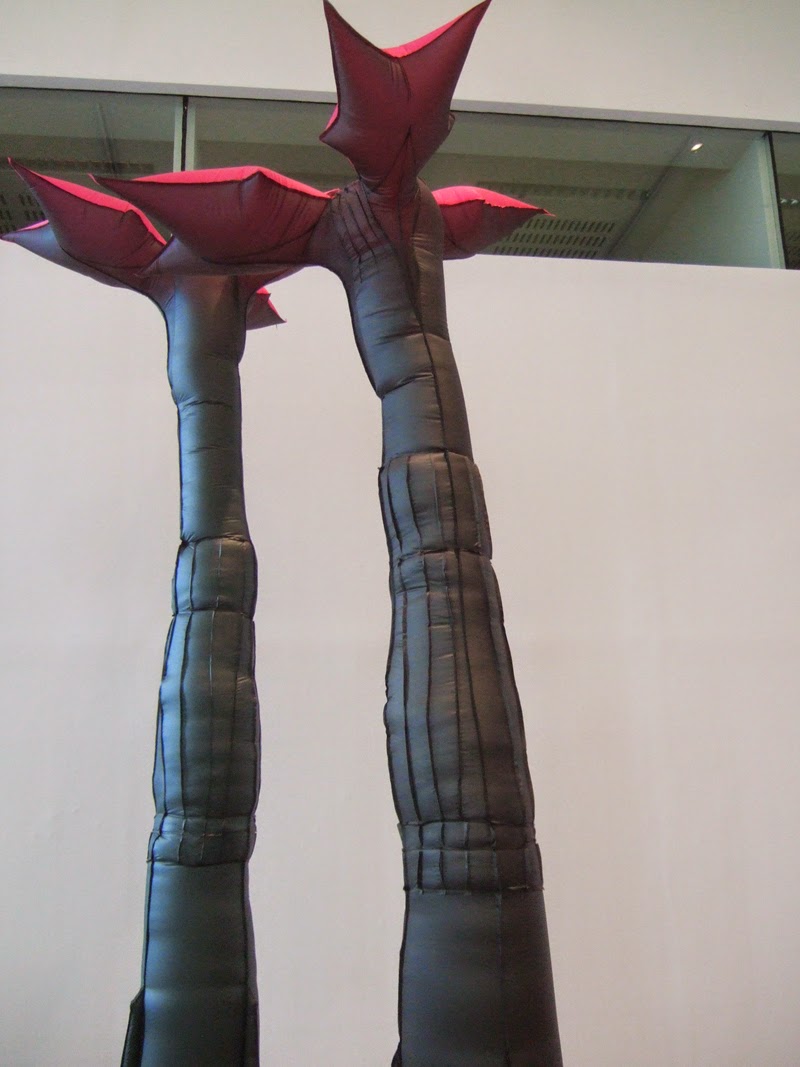 |
| Marvin Gaye Chetwynd 'Diorama' at Nottingham Contemporary |
Or maybe it is that they suddenly make sense all at once.
I was lucky enough to get over to Nottingham Contemporary to see Marvin Gaye Chetwynd’s first solo exhibition at a public gallery in Britain. I managed to visit not once but twice..
On my first visit I had only 30 minutes to do a whirlwind visit.
However I was so excited and so struck by the completely luscious and gorgeously sensual aesthetics of the work that I knew immediately that I would HAVE to get back before it closed.
On my second visit, in the show’s closing week, Chetwynd’s work’s uplifting effect on me hadn’t dimmed at all. It was fantastic to be charmed by Cousin Itt (from Addams Family fame) and also good to see the Brain Bug (during one of it’s mid-day animated phases) but for me the absolute winner of the show was the sequence of scaled-down dioramas of film sets.
 |
| Surprised by Cousin Itt |
 |
| The Brain Bug... a character taken from the, not very successful, sci-fi film StarshipTroopers |
For me the obvious fun that the two people giving their interpretations (both in basic schoolboy French - and the English translations of this) was so much fun.
 |
| The fragile and precarious nature of the construction of the Diorama somehow just makes it all the more appealing. |
“She is at home with the classics and with popular culture – and she uses one to give new meaning to the other.”
Performance is at the heart of Chetwynd’s practice so actually everything that was in the show at Nottingham supported either previous performances or was used in The Greenroom, the performance that was specially commissioned by Nottingham Contemporary.
You can watch an excerpt of the performance online.
In the exhibition booklet it says that Chetwynd likes the excitement of problem solving when on a low budget and also the sense of autonomy and spontaneity that comes from working on her own or in a small team.
One of the gallery attendants told me that Marvin Gaye Chetwynd has a troupe of people who work with her, these are people that she has made an emotional connection with- people who are on the same wavelength as her. I understand this approach as her work is so individual and definitely energy driven and I can see why people want to not just watch it but to also be part of it. The gallery attendant also said that the members of her troupe are very loyal and many have worked on several versions of her performances and filmed pieces.
Her work has an energy that I am very definitely attracted to.
I also like when we don’t know the whole story I enjoy when things are not completely explained; when there are loose ends in a story or performance. I have been an avid fan of street theatre for years and very definitely a fan of the absurd.
Marvin Gaye Chetwynd says, “I like Carnival Comedy and Nonsense”. Well me too!
I am drawn to the anarchic and the surreal and so (as I have said in previous blog posts) my touchstone in life is The Magic Roundabout. After confessing my love of the Magic Roundabout I always very quickly add, “Not the animated film but the original Magic Roundabout, the one with Eric Thompson as narrator.”
I now have a video player which I have kept for the sole purpose of being able to watch my VHS Magic Roundabout tape. If I am ever feeling sad or low the completely nonsensical Magic Roundabout stories help me regain my equilibrium. Of course life is messy and ends are rarely neatly tied up (as in sentimental Hollywood films or 'CSI Miami' - or 'CSI shitty' as I prefer to call it.)
 |
| My precious Magic Roundabout VHS tape |
Moments of mischief are at the heart of the Magic Roundabout because the narrator Eric Thompson (being a bit suspicious of the French) took it upon himself to rewrite the original French scripts that went with the puppet production.
“His calm tones, at odds with the hyperactive animation, lent a curiously mismatched feel.”
This 'not quite rightness' of the Magic Roundabout is one of the things that makes it appeal so much to me.
As a visual person most I often make connections based on visual qualities rather than themes. When I encountered Zoe Walker and Neil Bromwich’s show, ‘The Encampment of Eternal Hope’ at The Baltic, Gateshead UK in October 2012 I almost felt that I was in an alternate version of The Magic Roundabout; the simplified spikey inflatable trees were the link in my mind.
I felt like a small Florence in the Magic Roundabout garden.
 |
| Me (Kirsty E Smith) enjoying the participative aspect of The Encampment of Eternal Hope |
 |
| My view from one of the Encampment of Eternal Hope shelters |
 |
| Photograph from the Baltic website |
My thoughts on this so far are:
- positive energy,
- a maverick approach,
- anarchic humour
and
- eternal hope.











